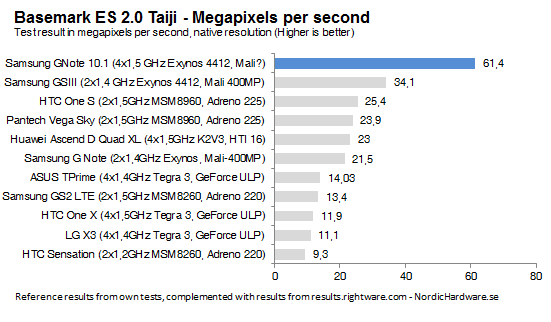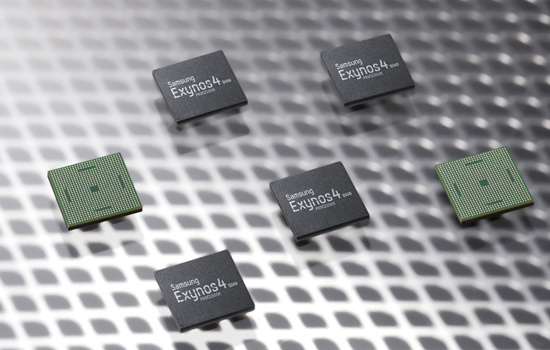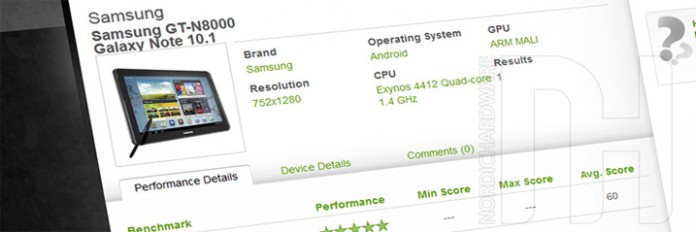It looks like Samsung is trying out new more powerful circuit solutions for their upcoming tablet Galaxy Note 10.1. Newly leaked performance data points towards a quad-core Exynos 4412 processor with the Mali-604T GPU which more than doubles the performance compared to the company’s current solutions.
Samsung Galaxy Note 10.1 were showcased already during the Mobile World Congress 2012 at the end of February and under the hood of the tablet were, except for a dedicated stylus – S Pen – also a dual-core processor. At that time Samsung did not want to reveal what circuit it was, but probobaly it was the same Exynos 4210 SoC which is used in the 5,3 inch device Galaxy Note among others, which is something that more recent specifications also has confirmed.
Even if the Galaxy Note 10.1 probably will be released with an Exynos 4210 processor that earlier data has implied, it looks like Samsung also are trying out their upcoming tablet with alot more powerful circuits.
During last week some new results from a mobile Android device appeared in the performance test Taiji at Rightware with the product name Samsung IMM76D.N8000XXALD6. This is the exact same identification that has been used earlier by a dual-core tablet with the Exynos 4210 processor and the Mali-400MP graphics circuit. But this device, and the associated performance results that was registered at Rightwares Powerboard database, points to a quad-core Exynos 4412 SoC with a yet to be named graphics circuit.
Samsung Galaxy Note 10.1 with an Exynos 4412 SoC on steroids?
The Exynos 4412 which is the heart in the new smartphone flag ship Galaxy S III is equipped with four Cortex-A9 CPU cores and an Mali-400MP graphics circuit with spiked clock frequencies. This is probably enough to make Galaxy S III the fastest smartphone on the market, but its nothing in comparison to the performance results that Samsung GT-N8000 now has produced.
The result NordicHardware managed to get their hands on – it isn’t available in Rightware’s public database – is recorded as 60 fps and puts all other devices in Taijis top list at shame. If you only look at the charts the performance is impressive but hardly revolutionary, although a big resason for this is due to Taiji’s performance test automatically runs in the devices native resolution, which is why for example the HTC One S and ASUS PadFone dominates the official result list with their qHD resolutions and performance between 48-49 fps. The Samsung GT-N8000 still produces significantly higher fps, but the most interesting thing is shown when we calculate the number of megapixels per second. Which gives pretty decent figures for the overall computation power independent from the devices resolution.

Samsung mysterious device completely annihilates the competitors here with a computation power of 61,4 megapixels per second, for example compared to 34,1 megapixels per second in Samsung Galaxy S III that according to the specification details use the same system processor. Worth noticing is also that the result for GT-N8000 is probably limited by vsync, the real performance can therefore be significantly higher than the 60 fps that has been registered by the Taiji test.
Although the CPU part in the device’s Exynos 4412 circuits can be equals it is beyond doubt that the graphics circuit is much more powerful.
Samsung and Mali-604T takes up the hunt for the new iPad?
The big question is which GPU that really hides beneith the surface in Samsung’s new mysterious tablet. We managed to dig up the detailed specification strings from the test logs and these are as follows for Galaxy Note 10.1 and Galaxy S III.
|
Samsung Galaxy Note 10.1 “hardware”: “smdk4x12”, “manufacturer”: “samsung”, “device”: “p4noterf”, “brand”: “samsung”, “display”: “IMM76D.N8000XXALD6”, “version_sdk”: “4.0.4”, “board”: “smdk4x12”, “version_code”: “1” GPU Vendor: ARM |
Samsung Galaxy S III “hardware”: “smdk4x12”, “manufacturer”: “samsung”, “device”: “m0”, “brand”: “samsung”, “display”: “IMM76D.I9300XWALE1”, “version_sdk”: “4.0.4”, “board”: “smdk4x12”, “version_code”: “1” GPU Vendor: ARM MALI-400MP |
The devices specifications points towards the same system processor, smdk4x12, which the application also more or less confirms as an Exynos 4412 SoC with four active CPU cores. But if we look at GPU Vendor the devices are different. The Galaxy S III is specificed to use the classical Mali-400MP GPU while the GPU on the Note 10.1 only is refered to as “ARM”. This indicates that we actually are talking about a new series of GPU’s, which with the performance results above in mind leads us to the conclusion that this can be the first real trace of the ARM Mali-604T.
It is then possible that Samsung has created a tablet version of the Exynos 4412 that apart from a quad-core CPU also has been upgraded with a significantly more powerful GPU from ARM’s next GPU generation. The SoC should in this case probably be both bigger and more power consuming than the circuit that Samsung has squeezed into the Galaxy S III. But this should also give the company the chance to beat Apple in GPU power.
ARM themselves claim that Mali-604T is up to 5 times as powerful as the Mali-400MP and we wouldn’t be surprised if the performance differences are even bigger than what is shown in the chart above since Taiji locks at a update frequency of 60 Hz on account of vsync. The Apple A5X that is used in the new iPad is by far the biggest system processor on the ARM market and even if the graphics performance is impressive the chip is built on a older GPU architecture, where Samsung should be able to beat Apple in both pure GPU power and efficiency.

If this really is the first sign of a GPU enriched Exynos 4412 SoC the question remains if it’s only Samsung that simply is running tests on it’s new system processor or if it actually will turn up a Galaxy Note 10.1 on the market with this more powerful SoC under the hood. When Samsung launches their first high resolutioned tablets this would have been a suitable SoC to introduce. The company is still expected to run with the new Exynos 5 series in their Galaxy Tab 11 with a 2 560 x 1 600 pixel resolution so there is still som questions waiting to be answered.
Our sources tells us that there are no signs that the results that has been published at Rightwares database are false or faked, something that the application has several solutions for detection of. This is probably the first indication on what we can expect from the next generation of mobile GPU’s. We can hardly wait.
















Good find, guys! Keep more info coming.
Nvidia really needs to get Tegra 3.5 out.
What’s the max resolution that this GPU can provide ?
We are not sure about this one in particular.
Samsung Exynos 5250 (2 x Cortex A15 and Mali-T604MP4) will support 2 560 x 1 600. I’ll make a guess and say whatever this is won’t be able to do the same, but I could be wrong 🙂
Why am I supposed to care about mega graphics on a tablet? For video games? I don’t give a sh*t about video games 🙄
[quote name=”Paulie”]Why am I supposed to care about mega graphics on a tablet? For video games? I don’t give a sh*t about video games :roll:[/quote]
Dear Video game creators,
Stop what you are doing RIGHT NOW! Can’t you see Paulie doesn’t give a shit about video games? You should be ashamed of yourselves!
[quote name=”Paulie”]Why am I supposed to care about mega graphics on a tablet? For video games? I don’t give a sh*t about video games :roll:[/quote]
Because GPU affects how smooth a tablet runs in everything from basic UI to photo editing tasks to scrolling through documents with handwritten text – these are not CPU only. Only a bimbo would think GPUs are for games only. Your not a bimbo….are you?